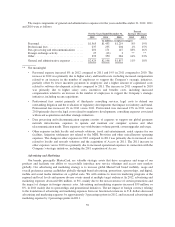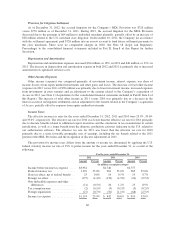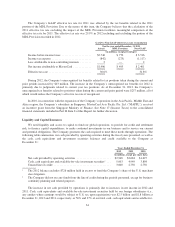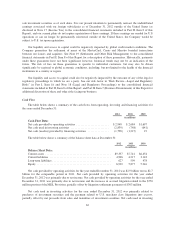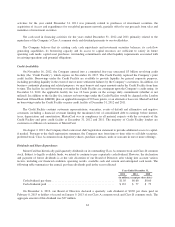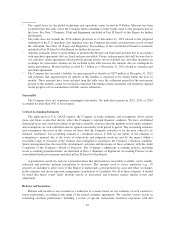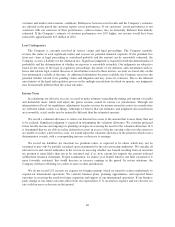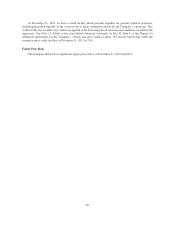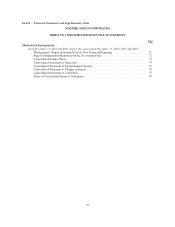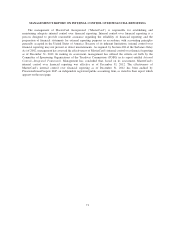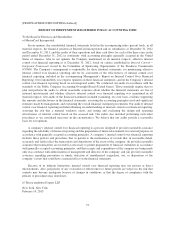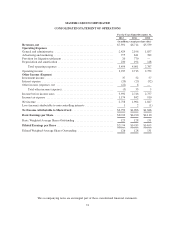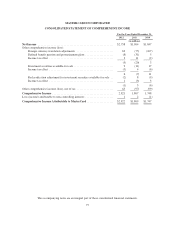MasterCard 2012 Annual Report Download - page 70
Download and view the complete annual report
Please find page 70 of the 2012 MasterCard annual report below. You can navigate through the pages in the report by either clicking on the pages listed below, or by using the keyword search tool below to find specific information within the annual report.customer and market and economic conditions. Differences between actual results and the Company’s estimates
are adjusted in the period the customer reports actual performance. If our customers’ actual performance is not
consistent with our estimates of their performance, contra-revenues may be materially different than initially
estimated. If the Company’s estimate of customer performance was 10% higher, net revenue would have been
reduced by approximately $25 million in 2012.
Loss Contingencies
The Company is currently involved in various claims and legal proceedings. The Company regularly
reviews the status of each significant matter and assesses its potential financial exposure. If the potential loss
from any claim or legal proceeding is considered probable and the amount can be reasonably estimated, the
Company accrues a liability for the estimated loss. Significant judgment is required in both the determination of
probability and the determination of whether an exposure is reasonably estimable. Our judgments are subjective
based on the status of the legal or regulatory proceedings, the merits of our defenses and consultation with in-
house and outside legal counsel. Because of uncertainties related to these matters, accruals are based only on the
best information available at the time. As additional information becomes available, the Company reassesses the
potential liability related to its pending claims and litigation and may revise its estimates. Due to the inherent
uncertainties of the legal and regulatory process in the multiple jurisdictions in which we operate, our judgments
may be materially different than the actual outcomes.
Income Taxes
In calculating our effective tax rate, we need to make estimates regarding the timing and amount of taxable
and deductible items which will adjust the pretax income earned in various tax jurisdictions. Through our
interpretation of local tax regulations, adjustments to pretax income for income earned in various tax jurisdictions
are reflected within various tax filings. Although we believe that our estimates and judgments discussed herein
are reasonable, actual results may be materially different than the estimated amounts.
We record a valuation allowance to reduce our deferred tax assets to the amount that is more likely than not
to be realized. Significant judgment is required in determining the valuation allowance. We consider projected
future taxable income and ongoing tax planning strategies in assessing the need for the valuation allowance. If it
is determined that we are able to realize deferred tax assets in excess of the net carrying value or to the extent we
are unable to realize a deferred tax asset, we would adjust the valuation allowance in the period in which such a
determination is made, with a corresponding increase or decrease to earnings.
We record tax liabilities for uncertain tax positions taken, or expected to be taken, which may not be
sustained or may only be partially sustained, upon examination by the relevant taxing authorities. We consider all
relevant facts and current authorities in the tax law in assessing whether any benefit resulting from an uncertain
tax position is more likely than not to be sustained and, if so, how current law impacts the amount reflected
within these financial statements. If upon examination, we realize a tax benefit which is not fully sustained or is
more favorably sustained, this would decrease or increase earnings in the period. In certain situations, the
Company will have offsetting tax credits or taxes in other jurisdictions.
We do not record U.S. income tax expense for foreign earnings which we intend to reinvest indefinitely to
expand our international operations. We consider business plans, planning opportunities, and expected future
outcomes in assessing the needs for future expansion and support of our international operations. If our business
plans change or our future outcomes differ from our expectations, U.S. income tax expense and our effective tax
rate could increase or decrease in that period.
66





